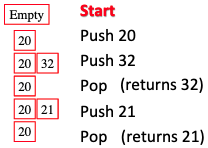Stack
- Last in, first out (LIFO), simple list works well for this.
- Think of a stack of plates.
- The add and remove operations are called push and pop.
All insertions and deletions take place at one end.
- To add an item to the stack you push it onto the top.
- To remote an item from the top you pop it.
In the example below the top of the stack is on the right hand side:

In depth
The stack is a defined area in RAM. Usually in RAM’s lower area above the global and static variables. The contents are accessed via the stack pointer, set to the upper end of the stack during initialisation. During execution, the stack grows down to the lower memory addresses.
Modern memory protections (DEP/ASLR) would prevent the damage cause by buffer overflows. DEP (Data Execution Prevention), marked regions of memory “Read-Only”. The read-only memory regions is where some user-input is stored (Example: The Stack), so the idea behind DEP was to prevent users from uploading shellcode to memory and then setting the instruction pointer to the shellcode. Hackers started utilising ROP (Return Oriented Programming) to get around this, as it allowed them to upload the shellcode to an executable space and use existing calls to execute it. With ROP, the attacker needs to know the memory addresses where things are stored, so the defense against it was to implement ASLR (Address Space Layout Randomisation) which randomises where everything is stored making ROP more difficult.
Users can get around ASLR by leaking memory addresses, but this makes exploits less reliable and sometimes impossible. For example the “Freefloat FTP Server” is trivial to exploit on Windows XP (before DEP/ASLR). However, if the application is ran on a modern Windows operating system the buffer overflow exists but it is currently non-trivial to exploit due to DEP/ASLR because there’s no known way to leak memory addresses.
Stack Frames
The base pointer points to the beginning (base) of the stack in contrast to the stack pointer, which points to the top.
As the stack grows it is divided into regions called Stack Frames, which allocate the required memory in the stack for the corresponding function. It defines a frame with the beginning (EBP) and the end (ESP) that is pushed onto the stack when a function is called.
Since the memory is built on a LIFO data structure, the first step is to store the previous EBP position on the stack, which can be restored after the function completes.
Prologue
(gdb) disas bowfunc
Dump of assembler code for function bowfunc:
0x0000054d <+0>: push ebp # <---- 1. Stores previous EBP
0x0000054e <+1>: mov ebp,esp # <---- 2. Creates new Stack Frame
0x00000550 <+3>: push ebx
0x00000551 <+4>: sub esp,0x404 # <---- 3. Moves ESP to the top
<...SNIP...>
0x00000580 <+51>: leave
0x00000581 <+52>: ret Epilogue
(gdb) disas bowfunc
Dump of assembler code for function bowfunc:
0x0000054d <+0>: push ebp
0x0000054e <+1>: mov ebp,esp
0x00000550 <+3>: push ebx
0x00000551 <+4>: sub esp,0x404
<...SNIP...>
0x00000580 <+51>: leave # <----------------------
0x00000581 <+52>: ret # <--- Leave stack frameStack API
A basic interface is:
public interface StringStack {
StringStack();
void push(String item);
String pop();
boolean isEmpty();
// optional
int size();
}Applications
- Reverse a string
- Undo mechanism in text editors
- Web pages navigation in a web browser
- Compilers – syntax evaluation